My boys’ eyes used to light up when roast beef was on the menu, because they knew Yorkshire Puddings might just be in the offing. Great big crispy-topped puffs with an almost custardy interior were receptacles for large quantities of gravy. I would make 12 yorkies in muffins pans, which you think might be adequate for the 4 or 5 folks at the table, but there was always someone at the end of the meal wishing there had been just one left to fill the remaining empty space in their appetite. My dad used to call a final slice of bread and gravy at the end of a meal a “Ukrainian Sundae”; the last Yorkie was its English cousin.
At cooking school, we were taught the classic ratio: equal parts by volume of eggs, milk and flour would yield the desired result. Many family recipes, and indeed many cookbook recipes and a few internet recipes, skimp on the eggs. If your Yorkshire puddings are unreliable performers, sometimes turning out like doughy little hockey pucks, too little egg may be part of the problem.
I spent a happy few years developing and testing recipes for a living, so testing day is always a joy for me. I wanted to develop a one-egg Yorkshire Pudding recipe for the toaster oven. Eggs come in a range of sizes from Peewee to Jumbo, but most of us buy large eggs. A large egg measures out just shy of ¼ cup, so for my first trial I fudged a little and tried ¼ cup each of flour and milk with one egg. Not bad, but not quite perfect. I had better results with 1 egg, 3 Tablespoons of flour and 3 Tablespoons of milk. Good. Ratio established. One pretty generously sized Yorkshire pudding with good loft and nice texture.
The second most important factor in making a perfect Yorkie is heat: The oven, the pan and the oil should be “cracking hot” (which must be a proper culinary term, because every chef I have met uses it) before the batter goes in. My son Mica will debate this point, but I have had mixed success with his “cold pan” method. He can do it his way — I suggest you do it mine.
The final variable in the whole process is the cooking vessel. While I have used a good heavy-grade muffin pan in the past to make a full five-egg batch, my current favorite is a heavy, deep number particularly engineered for making Yorkshire Puddings, from Nordic Ware. I picked it up for an exorbitant amount of money from a store in Edmonton (you know who you are – my secret vice). Unfortunately, it doesn’t come in a one or two-hole model.

I found some nice little cake pans that showed promise, and I had quite good success with tin-foil mini loaf pans (except that the Yorkies stuck to their thin bottoms), but my most satisfactory result came from one of my favorite multi-taskers, my small cast iron skillet. I believe that its thick base, heat-retaining walls and perfectly seasoned patina contribute to a Yorkshire Pudding that is crispy, high-rising, and conveniently shaped into a lovely bowl to hold whatever gravy-laden goodness it has been created to contain. Ahhhhhh.


Yorkshire Pudding for One
Ingredients:
1 large egg
3 Tbsp all-purpose flour
3 Tbsp milk (low fat is fine)
1 tsp oil (plus more for the pan)
Pinch of salt (or seasoned salt; also dried herbs could be added)

Method:
Pre-heat the oven (a toaster oven works very well) to 425°F. Pour 1 teaspoon of oil into each of 2 standard-sized muffin cups, or 2 teaspoons of oil into a mini-loaf pan or small cast-iron skillet or similar pan. Heat the pan and oil for at least 10 minutes before pouring in the batter. You will likely be able to detect the aroma of hot pan/hot oil when the desired temperature has been achieved. Be watchful – if you heat the oil too long, it will catch fire.
Break the egg into a 2-cup liquid measuring cup (which makes it easier to pour the batter into the hot pan when the time comes). Whisk to combine yolks and whites.

Add flour, milk, oil, salt, and optional seasonings. Whisk until smooth. Let rest while the pan finishes heating.


When everything is hot enough, pull the oven rack out just far enough for you to pour the batter into the pan. The batter should go “ssssssss” when it hits the oil. Work quickly so you lose as little heat from the open oven door as possible.
Bake until puffed, golden and firm. My toaster oven is a convection model: the Yorkshire Pudding in both the skillet and in the mini-loaf pan took just under 20 minutes to finish.

Fill with re-heated stew, sauteed mushrooms with reduced cream, leftover chicken and gravy, creamed tuna, even small-dice stir-fried stuff, as long as there is some kind of sauce. Or just leftover gravy. Real gravy, not that stuff in a packet or a can. We can talk about that another time.

Giving way to my propensity for lateral thinking, I got out some no-yolk liquid egg product to see if I could get a good result with two tablespoons of each of the main ingredients to make a one-muffin-cup-sized Yorkie. The results are shown to the right: Real eggs on the left, liquid eggs on the right. Not much of a contest, really.
I’m not a huge fan of the no-yolk product from a flavor standpoint, but I understand some folks need to use it. Don’t use it for Yorkshire Pudding, though. Make a nice biscuit to soak up the gravy instead.


Yorkshire Pudding for You and Three Friends
5 large eggs
1 cup flour
1 cup milk
2 Tbsp oil
1 tsp salt (and optional flavoring agents)
Use the same method, except you might want to use an 8-cup measuring bowl to accommodate whisking and mixing.
This much batter can be baked in a 12-hole standard muffin pan, a 24-hole mini muffin pan (for little tiny yorkies, suitable for hors d’oeuvres), a 6-hole Yorkshire Pudding pan (deeper holes, larger volume), an 8- or 9-inch heavy baking pan, or a large (maximum 12-inch) cast-iron skillet. Adjust the amount of oil according to the cooking vessel you choose – a half teaspoon in the muffin pans, a full teaspoon in the Yorkshire Pudding pans, a couple of tablespoons in the larger pans.
Historically, Yorkshire Pudding was cooked in the dripping pan under the spit-roasting beef or mutton, with drippings continuing to fall onto it while it baked. While I suppose this practice could be replicated, perhaps even on the barbeque, I will leave such experimentation to more adventurous souls than I.
PS — if you add a little sugar to the recipe, and bake it off in a cast-iron frying pan, you can fill the interior with carmelized apples or peaches and sprinkle it with icing sugar and call it a “Dutch Baby”. Works for both the single serving and the multiple serving recipes. Showstopper brunch!



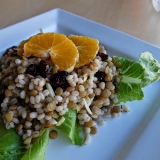
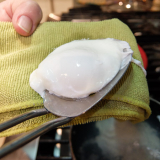
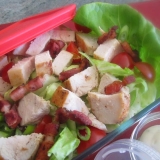

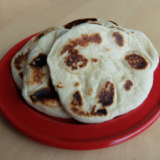
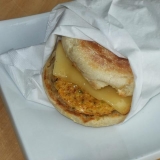
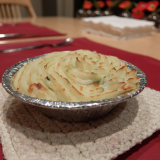
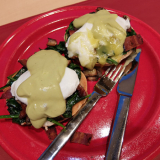
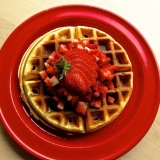
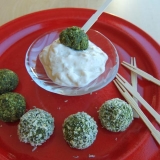
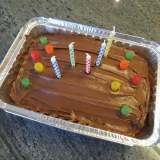
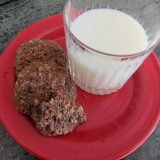
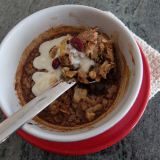
Leave A Comment